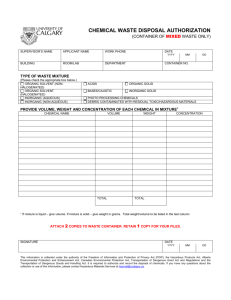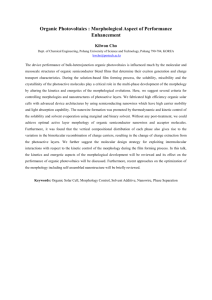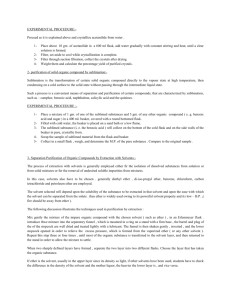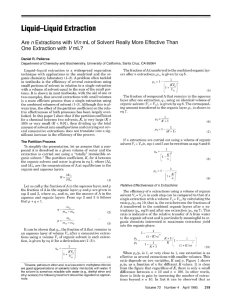CHM 210 PROBLEMS FOR 5/31/01 FOR 5/31/01 HAND IN THE
advertisement
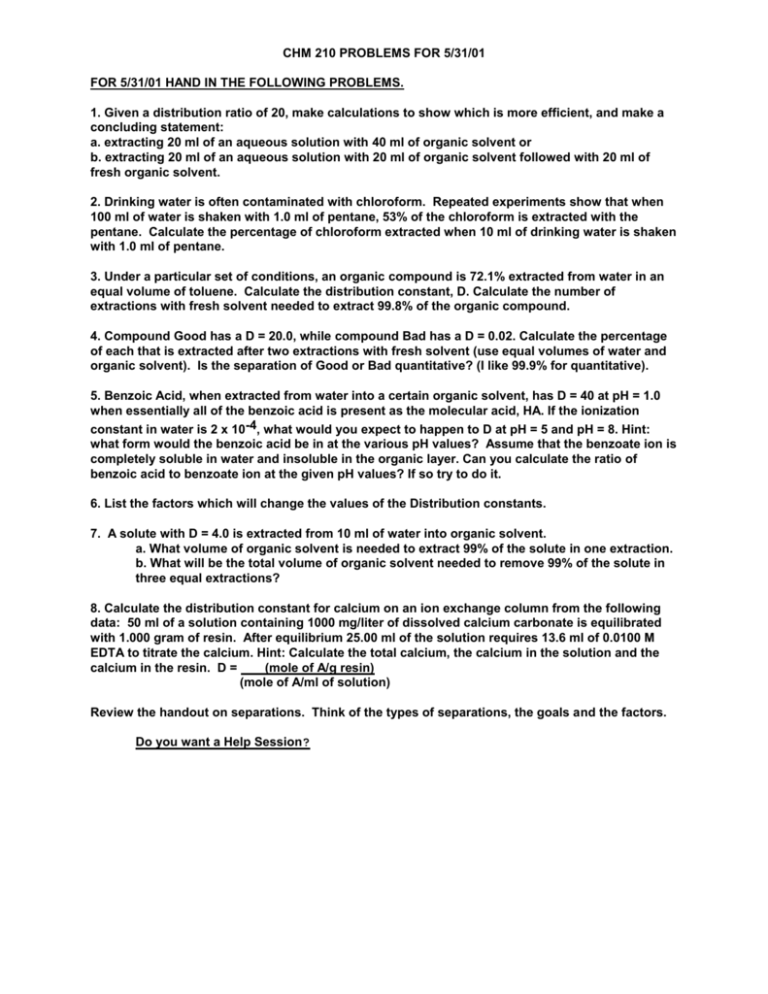
CHM 210 PROBLEMS FOR 5/31/01 FOR 5/31/01 HAND IN THE FOLLOWING PROBLEMS. 1. Given a distribution ratio of 20, make calculations to show which is more efficient, and make a concluding statement: a. extracting 20 ml of an aqueous solution with 40 ml of organic solvent or b. extracting 20 ml of an aqueous solution with 20 ml of organic solvent followed with 20 ml of fresh organic solvent. 2. Drinking water is often contaminated with chloroform. Repeated experiments show that when 100 ml of water is shaken with 1.0 ml of pentane, 53% of the chloroform is extracted with the pentane. Calculate the percentage of chloroform extracted when 10 ml of drinking water is shaken with 1.0 ml of pentane. 3. Under a particular set of conditions, an organic compound is 72.1% extracted from water in an equal volume of toluene. Calculate the distribution constant, D. Calculate the number of extractions with fresh solvent needed to extract 99.8% of the organic compound. 4. Compound Good has a D = 20.0, while compound Bad has a D = 0.02. Calculate the percentage of each that is extracted after two extractions with fresh solvent (use equal volumes of water and organic solvent). Is the separation of Good or Bad quantitative? (I like 99.9% for quantitative). 5. Benzoic Acid, when extracted from water into a certain organic solvent, has D = 40 at pH = 1.0 when essentially all of the benzoic acid is present as the molecular acid, HA. If the ionization constant in water is 2 x 10-4, what would you expect to happen to D at pH = 5 and pH = 8. Hint: what form would the benzoic acid be in at the various pH values? Assume that the benzoate ion is completely soluble in water and insoluble in the organic layer. Can you calculate the ratio of benzoic acid to benzoate ion at the given pH values? If so try to do it. 6. List the factors which will change the values of the Distribution constants. 7. A solute with D = 4.0 is extracted from 10 ml of water into organic solvent. a. What volume of organic solvent is needed to extract 99% of the solute in one extraction. b. What will be the total volume of organic solvent needed to remove 99% of the solute in three equal extractions? 8. Calculate the distribution constant for calcium on an ion exchange column from the following data: 50 ml of a solution containing 1000 mg/liter of dissolved calcium carbonate is equilibrated with 1.000 gram of resin. After equilibrium 25.00 ml of the solution requires 13.6 ml of 0.0100 M EDTA to titrate the calcium. Hint: Calculate the total calcium, the calcium in the solution and the calcium in the resin. D = (mole of A/g resin) (mole of A/ml of solution) Review the handout on separations. Think of the types of separations, the goals and the factors. Do you want a Help Session?


